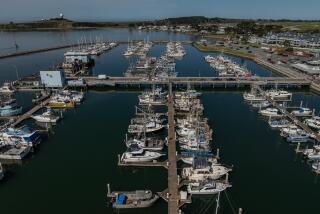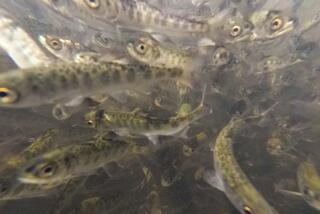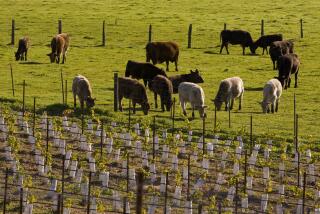Fish Farms’ Ugly Underside
That bargain hunk of salmon you’re about to fork into is 50% higher in fat than the fish you used to eat, but lower in healthful omega-3 fatty acids. It’s probably got more PCBs and other toxins and gets its rich coral hue from an artificial colorant that’s been linked to retinal damage in humans.
Even more unappetizing, though, is what the salmon farming industry is doing to the marine environment, especially on the western coast of Canada, as Times reporter Kenneth R. Weiss revealed in a recent story. Farms of domesticated Atlantic salmon pollute pristine coastal waters, spread disease to wild fish and consume huge amounts of seafood, and hundreds of thousands of their fish escape from netted pens into the wild, where they endanger both ocean and river wildlife.
So what’s so attractive about farm-raised salmon, aside from synthetic rosiness? Low prices. Those prices, though, don’t reflect the actual cost of salmon farming. An independent inquiry last year in Canada found that salmon farming was hurting the wild-fishing industry and Indians who depend on a clean environment for foods important to their diets.
On top of that is the cost that the public will have to suffer if massive eradication efforts are needed to cull domesticated salmon from wild habitat. Already, escaped fish have produced young in Canadian rivers where wild salmon spawn. Norway, the biggest salmon producer, had to poison its rivers to kill parasites from farmed fish that spread to the wild.
An industry spokeswoman agreed that salmon farming had been an environmental nightmare. Many farms are responding, she said, with better pens, more efficient use of food and relocation to coastal areas far from wild-salmon runs and marine mammal hangouts. She didn’t blame the customers who refused to buy farmed salmon because of the damage the farms caused; the industry will have to reform to gain their trust. Given the global nature of salmon farming, though, and the dearth of regulations on a growing industry, such change will come slowly, if not disastrously late -- unless consumers demand it.
It won’t require that consumers forswear salmon. All that’s needed is that they be smart and demanding. The necessary information can be had with the help of three Web sites. The Monterey Bay Aquarium offers a quick reference list of eco-safe and environmentally unfriendly seafood choices at www.mbayaq.org/cr/cr_seafoodwatch/sfw_regional.asp. More specialized lists are available from the National Audubon Society, www.magazine.audubon.org/seafood/guide/, and the Marine Stewardship Council, www.msc.org. At these sites, salmon lovers will learn that Alaskan wild salmon is a better environmental choice than farmed salmon and that if the industry cleans up its act, farmed salmon will make the A-list.
Remember how consumer demand led the tuna industry to back off from using nets that trapped dolphins? The public must be as vigilant about incidental damage to marine and river wildlife from aquatic farming.
More to Read
Sign up for Essential California
The most important California stories and recommendations in your inbox every morning.
You may occasionally receive promotional content from the Los Angeles Times.










